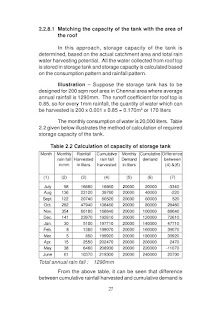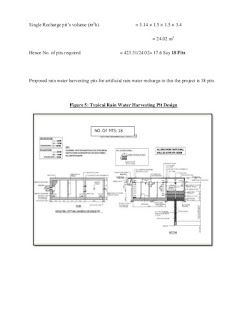Design of storage tanks
The volume of the storage tank can be determined by the following factors:
The volume of the storage tank can be determined by the following factors:
- Number of persons in the household: The greater the number of persons, the greater the storage capacity required to achieve the same efficiency of fewer people under the same roof area.
- Per capita water requirement: This varies from household to household based on habits and also from season to season. Consumption rate has an impact on the storage systems design as well as the duration to which stored rainwater can last.
- Average annual rainfall
- Period of water scarcity: Apart from the total rainfall, the pattern of rainfall -whether evenly distributed through the year or concentrated in certain periods will determine the storage requirement. The more distributed the pattern, the lesser the size.
- Type and size of the catchment:Type of roofing material determines the selection of the runoff coefficient for designs. Size could be assessed by measuring the area covered by the catchment i.e., the length and horizontal width. Larger the catchment, larger the size of the required cistern (tank).
Dry season demand versus supply approach
In this approach there are three options for determining the volume of storage:
In this approach there are three options for determining the volume of storage:
- Matching the capacity of the tank to the area of the roof
- Matching the capacity of the tank to the quantity of water required by its users
- Choosing a tank size that is appropriate in terms of costs, resources and construction methods.
IllustrationSuppose the system has to be designed for meeting drinking water requirement of a five-member family living in a building with a rooftop area of 100 sq. m. The average annual rainfall in the region is 600 mm (average annual rainfall in Delhi is 611 mm). Daily drinking water requirement per person (drinking and cooking) is 10 litres.
| Design procedure: Following details are available: Area of the catchment (A) = 100 sq. m. Average annual rainfall (R) = 611 mm (0.61 m) Runoff coefficient (C) = 0.85 1. Calculate the maximum amount of rainfall that can be harvested from the rooftop: Annual water harvesting potential = 100 x 0.6 x 0.85 = 51 cu. m. (51,000 litres) 2. Determine the tank capacity: This is based on the dry period, i.e., the period between the two consecutive rainy seasons. For example, with a monsoon extending over four months, the dry season is of 245 days. 3. Calculate drinking water requirement for the family for the dry season = 245 x 5 x 10 = 12,250 litres As a safety factor, the tank should be built 20 per cent larger than required, i.e., 14,700 litres. This tank can meet the basic drinking water requirement of a 5-member family for the dry period. A typical size of a rectangular tank constructed in the basement will be about 4.0 m x 4.0 m x 1.0 m |
Salient features of this approach:
- Simplest approach to system design but is relevant only in areas where distinct dry seasons exist
- Provides a rough estimate of storage volume requirements
- This method does not take into account variations between different years, such as the occurrence of drought years. It also entirely ignores rainfall input and the capacity of the catchment to deliver the runoff necessary to fill the storage tank.
- This technique can be used in the absence of any rainfall data and is easily understandable to the layperson.These points are especially relevant when designing systems in the remote areas of developing countries where obtaining reliable rainfall data can be difficult.
http://www.rainwaterharvesting.org/Urban/Design_Storage.htm
manual on rain water harvesting Central ground water board
+++++++++++++++++++++++++++++++++++
web site for rain water harvesting


















